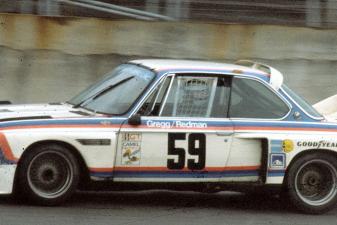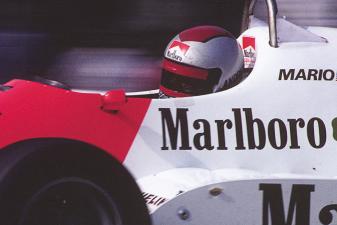The Blue Oval Builds a GTX Monster
An Excerpt from IMSA 1969–1989

The following is an excerpt from the book, IMSA: 1969-1989, by Mitch Bishop and Mark Raffauf.
The Camel GT Series was flying high by 1981. Camel was back as the title sponsor and the turbocharged Porsche 935 was clearly the machine to beat. Although it was the year of the first true IMSA GTP cars (Brian Redman’s Chevy-powered Lola T-600 would go on to win the championship), that didn’t prevent some manufacturers from entering the fray with brand new GTX machines that featured turbocharged engines, wild bodywork, and huge rear wings. (Banner image: In partnership with Zakspeed, Ford developed the Mustang GTX contender for the 1981 season using a 1.6-liter, four-cylinder turbocharged engine that produced upwards of 600bhp. Photo credit: Bob Harmeyer)
After a decade-long hiatus, Ford formally re-entered the U.S. racing scene in 1981. With the decline of the Trans-Am, the Camel GT Series became a top priority for Ford Special Vehicle Operations (SVO), which called on Bill Scott Racing for help. The team fit a 1.6-liter, single turbo, four-cylinder engine into a re-bodied Zakspeed Capri chassis that was only slightly evocative of a Mustang street car. Klaus Ludwig, a German road racing star who had won the 1979 24 Hours of Le Mans with Bill and Don Whittington, was hired to drive.
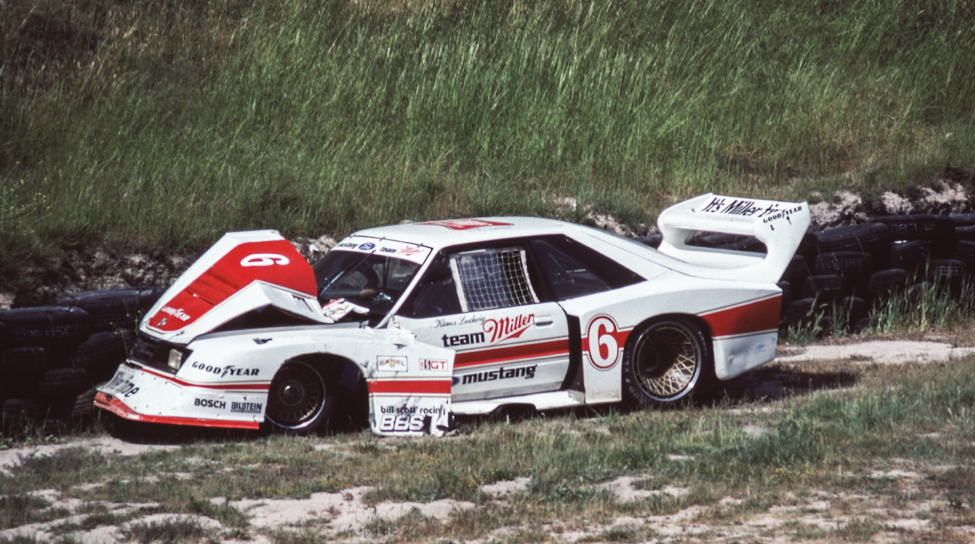 After putting the Zakspeed Mustang on pole for the Laguna Seca round in May, 1981, Ludwig crashed out of the race after 33 laps. Ironically, the crash helped Brian Redman take the first-ever win for an IMSA GTP car. Peter Gloede
After putting the Zakspeed Mustang on pole for the Laguna Seca round in May, 1981, Ludwig crashed out of the race after 33 laps. Ironically, the crash helped Brian Redman take the first-ever win for an IMSA GTP car. Peter Gloede
Using updated GTX rules, the team had almost complete freedom to re-design the Mustang bodywork for maximum grip, including a huge rear wing, extended front splitter and wide fender flares. Producing upwards of 600bhp, the car was blindingly quick. The team debuted the car with Miller beer sponsorship at Road Atlanta in April of 1981, where Ludwig qualified 13th and sliced his way through the field to finish on the back wing of John Fitzpatrick’s winning Porsche 935. Ford was back in American road racing in a big way. Ludwig went on to win at Brainard and Sears Point, proving the quickness of the new car, but not necessarily the reliability; he would finish tenth in points at the end of the 1981 season.
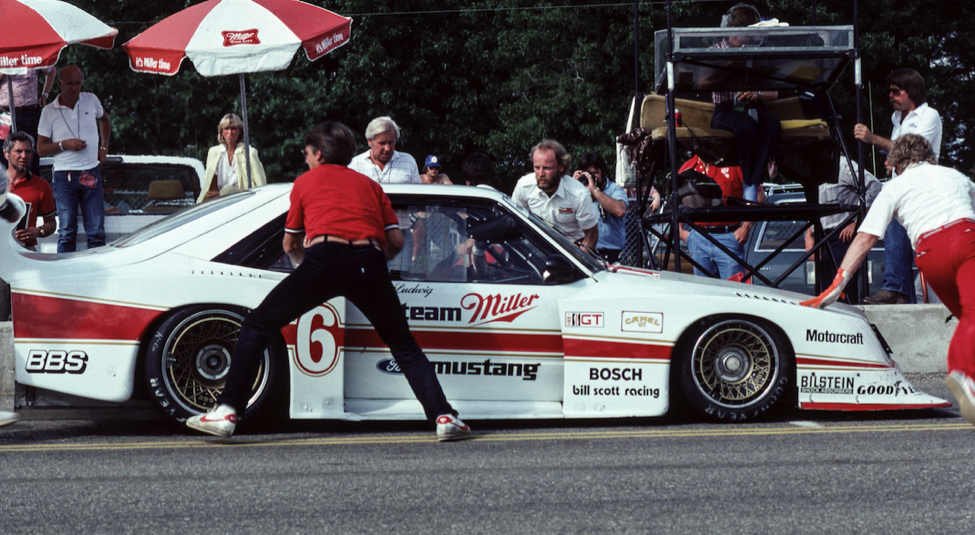 Klaus Ludwig comes in for a pit stop during the Brainerd round of the IMSA Camel GT Series in 1981. He would go on to win the race in his Ford Mustang GTX. Peter Gloede
Klaus Ludwig comes in for a pit stop during the Brainerd round of the IMSA Camel GT Series in 1981. He would go on to win the race in his Ford Mustang GTX. Peter Gloede
Using an upgraded 2.1-liter version of the engine producing close to 675bhp, Zakspeed the speedy Fords would race again in 1982 and the first half of 1983 under factory sponsorship with Ludwig sharing driving duties with Rick Mears and Kevin Cogan, who were on loan from Roger Penske’s Indy car team when dates didn’t conflict, plus occasional drives from Bobby Rahal, Geoff Brabham, and Tim Coconis. The 1981 season turned out to be the start of a long involvement by Ford’s Special Vehicles Operations at the highest levels of IMSA racing.
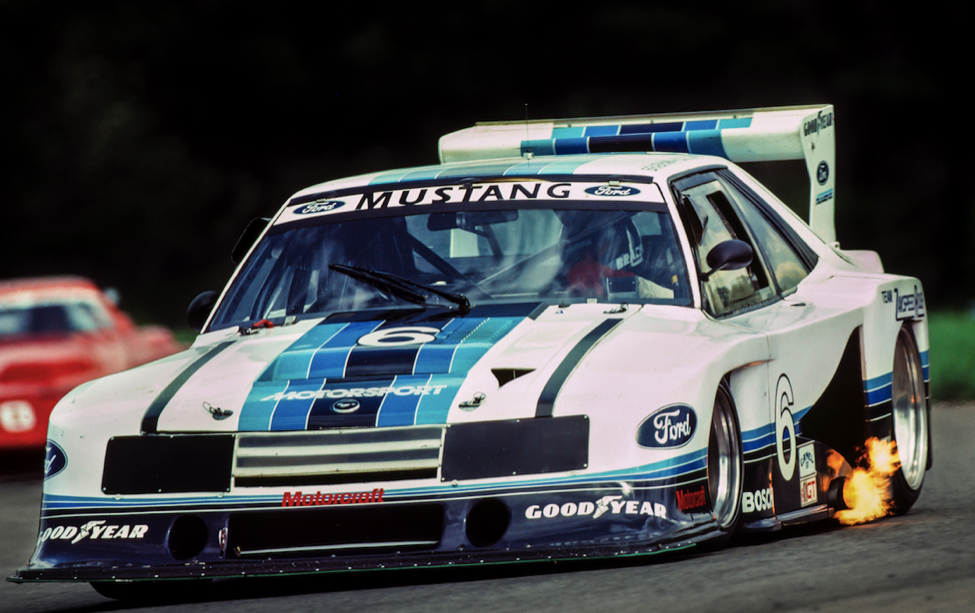 Geoff Brabham pilots the now factory sponsored turbocharged Ford Mustang GTX at Road Atlanta in 1983. Ford/Zakspeed continued to develop the car in 1982 and early 1983, prior to the delivery of the all-new Ford Mustang GTP. Whit Bazemore
Geoff Brabham pilots the now factory sponsored turbocharged Ford Mustang GTX at Road Atlanta in 1983. Ford/Zakspeed continued to develop the car in 1982 and early 1983, prior to the delivery of the all-new Ford Mustang GTP. Whit Bazemore
Stay tuned for more excerpts from our upcoming book, IMSA: 1969-1989, available now for presale!
The Camel GT Series was flying high by 1981. Camel was back as the title sponsor and the turbocharged Porsche 935 was clearly the machine to beat. Although it was the year of the first true IMSA GTP cars (Brian Redman’s Chevy-powered Lola T-600 would go on to win the championship), that didn’t prevent some manufacturers from entering the fray with brand new GTX machines that featured turbocharged engines, wild bodywork, and huge rear wings. (Banner image: In partnership with Zakspeed, Ford developed the Mustang GTX contender for the 1981 season using a 1.6-liter, four-cylinder turbocharged engine that produced upwards of 600bhp. Photo credit: Bob Harmeyer)
After a decade-long hiatus, Ford formally re-entered the U.S. racing scene in 1981. With the decline of the Trans-Am, the Camel GT Series became a top priority for Ford Special Vehicle Operations (SVO), which called on Bill Scott Racing for help. The team fit a 1.6-liter, single turbo, four-cylinder engine into a re-bodied Zakspeed Capri chassis that was only slightly evocative of a Mustang street car. Klaus Ludwig, a German road racing star who had won the 1979 24 Hours of Le Mans with Bill and Don Whittington, was hired to drive.
 After putting the Zakspeed Mustang on pole for the Laguna Seca round in May, 1981, Ludwig crashed out of the race after 33 laps. Ironically, the crash helped Brian Redman take the first-ever win for an IMSA GTP car. Peter Gloede
After putting the Zakspeed Mustang on pole for the Laguna Seca round in May, 1981, Ludwig crashed out of the race after 33 laps. Ironically, the crash helped Brian Redman take the first-ever win for an IMSA GTP car. Peter GloedeUsing updated GTX rules, the team had almost complete freedom to re-design the Mustang bodywork for maximum grip, including a huge rear wing, extended front splitter and wide fender flares. Producing upwards of 600bhp, the car was blindingly quick. The team debuted the car with Miller beer sponsorship at Road Atlanta in April of 1981, where Ludwig qualified 13th and sliced his way through the field to finish on the back wing of John Fitzpatrick’s winning Porsche 935. Ford was back in American road racing in a big way. Ludwig went on to win at Brainard and Sears Point, proving the quickness of the new car, but not necessarily the reliability; he would finish tenth in points at the end of the 1981 season.
 Klaus Ludwig comes in for a pit stop during the Brainerd round of the IMSA Camel GT Series in 1981. He would go on to win the race in his Ford Mustang GTX. Peter Gloede
Klaus Ludwig comes in for a pit stop during the Brainerd round of the IMSA Camel GT Series in 1981. He would go on to win the race in his Ford Mustang GTX. Peter GloedeUsing an upgraded 2.1-liter version of the engine producing close to 675bhp, Zakspeed the speedy Fords would race again in 1982 and the first half of 1983 under factory sponsorship with Ludwig sharing driving duties with Rick Mears and Kevin Cogan, who were on loan from Roger Penske’s Indy car team when dates didn’t conflict, plus occasional drives from Bobby Rahal, Geoff Brabham, and Tim Coconis. The 1981 season turned out to be the start of a long involvement by Ford’s Special Vehicles Operations at the highest levels of IMSA racing.
 Geoff Brabham pilots the now factory sponsored turbocharged Ford Mustang GTX at Road Atlanta in 1983. Ford/Zakspeed continued to develop the car in 1982 and early 1983, prior to the delivery of the all-new Ford Mustang GTP. Whit Bazemore
Geoff Brabham pilots the now factory sponsored turbocharged Ford Mustang GTX at Road Atlanta in 1983. Ford/Zakspeed continued to develop the car in 1982 and early 1983, prior to the delivery of the all-new Ford Mustang GTP. Whit BazemoreStay tuned for more excerpts from our upcoming book, IMSA: 1969-1989, available now for presale!


